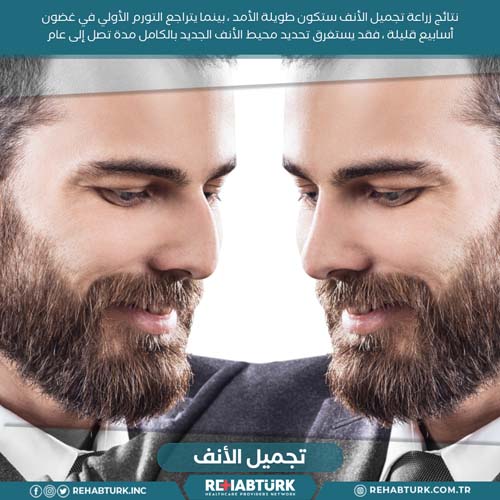Rhinoplasty in Türkiye
Rhinoplasty is surgery to change the shape of the nose by modifying the bone or cartilage. Rhinoplasty is one of the most common types of plastic surgery.
Reasons for doing rhinoplasty
People undergo rhinoplasty to repair their nose after an injury, to correct breathing problems or birth defects, or because they are unhappy with the way their nose looks.
Possible changes that the surgeon can make with rhinoplasty include:
- Change in the size of the nose
- Change in the angle of the nose
- Nose bridge straightening
- Reshaping the tip of the nose
- Narrowing of the nostrils
If rhinoplasty is more intended to improve appearance than to be curative, you should wait until the growth of the nasal bone is complete. This means about 15 years for girls. But young men’s noses may continue to grow until they are a little older. However! It can be performed at a younger age if the goal of the surgery is to treat poor breathing.
Operation risks
All surgeries carry some risks, including infection, bleeding, or a bad reaction to anesthesia. Rhinoplasty may also increase the risk of:
- breathing difficulties
- nosebleeds
- Numbness in the nose
- Asymmetric nose
- stigmata
Sometimes, patients are not satisfied with their previous nose surgery. If you want to perform a second surgery, you must wait until the nose is completely healed before performing the operation again. This takes an entire year.

Preparing for rhinoplasty
The patient must first meet with the surgeon to discuss whether he is a good candidate for rhinoplasty. Where the patient shares his desire for the surgery and what he hopes to achieve through the procedure.
The surgeon checks the patient’s medical history and asks about any medications and current medical conditions. If he has hemophilia , a disorder that causes excessive bleeding, the surgeon will likely recommend no surgery.
The surgeon also performs a physical examination, looking closely at the skin inside and outside the nose to determine what kind of changes can be made. The surgeon may order blood tests or other lab tests.
The surgeon considers whether any additional surgery should be performed at the same time. For example, some people get a chin augmentation at the same time as a rhinoplasty!
This consultation also includes imaging the nose from different angles. This footage is used to assess the long-term results of surgery and can also be referred to during surgery.
Be sure to understand the costs of rhinoplasty surgery. Whereas, if it is done for cosmetic reasons, it is unlikely that it will be covered by insurance.
Pain relievers containing ibuprofen or aspirin should be avoided for two weeks before surgery and two weeks after surgery. These drugs slow blood clotting and can increase bleeding. Therefore, the surgeon must be told about the medications and supplements that the patient is taking so that he can advise him on whether or not to continue taking them.
Smokers have a more difficult time recovering from rhinoplasty, because cigarettes slow down the healing process. Nicotine narrows blood vessels, which results in less oxygen and blood getting to the tissues. Quitting smoking before and after surgery can help the healing process.
How to perform rhinoplasty
Rhinoplasty can be performed in a hospital, doctor’s office, or surgical outpatient clinic. Where the doctor uses local anesthesia or general anesthesia. If this procedure is of a simple type, then the patient gets local anesthesia, which also numbs the face. The patient may also be given medication through an IV that makes him dizzy but keeps him awake.
As for when using general anesthesia, it is possible to get anesthesia by inhalation or intravenously, which makes him unconscious. Children are usually given general anesthesia.
Once the patient is sedated or unconscious, the surgeon makes incisions between or inside the nostrils. The doctor separates the skin from the cartilage or bone and then begins to reshape. If the new nose needs an extra amount of cartilage, the doctor may remove some of the ear cartilage or the inner part of the nose.
If more is needed, the patient may receive an implant or bone graft. A bone graft is an extra bone added to the bone in your nose.
The operation usually takes between one and two hours. If the surgery is of a complex type, it may take longer.
Recovery from surgery
The surgeon may place a plastic or metal splint on the nose after surgery. The splint helps the nose retain its new shape while it heals. Bags or splints may also be placed inside the nose to stabilize the nasal septum, which is the part between the nostrils.
The patient is monitored in the recovery room for at least a few hours after surgery. If all is well, the patient is discharged later that day. The patient also needs someone to take him home because the effect of anesthesia remains for a period of time. In the event that the procedure is complicated, the patient may have to stay in the hospital for a day or two.
The patient needs to rest to reduce bleeding and swelling with the head raised above the chest. The patient may feel congested if the nose is swollen or filled with cotton, and people are usually asked to keep splints and bandages in place for up to a week after surgery. There may be absorbable stitches, which means they dissolve and do not have to be removed. If the sutures are not absorbable, the patient needs to visit the doctor again a week after the surgery to remove the sutures.
Memory lapses, impaired judgment, and slowed reaction are common effects of medications used during surgery. A friend or relative is asked to stay with the patient the first night.
The patient may experience drainage and bleeding for several days after the surgery. A piece of gauze is used under the nose called a gonorrhea pad, which can absorb blood and mucus, and the doctor is told how often it should be changed.
The patient may get a headache and feel a swollen face, and the doctor may prescribe painkillers.
Your doctor may also advise you to avoid the following for a few weeks after surgery:
- Running and other strenuous physical activities
- swimming
- Nasal blowing
- excessive chewing
- Laughing, smiling, or other facial expressions that require a lot of movement
- Pull the clothes over the head
- Put glasses on the nose
- Brushing teeth vigorously
Sunlight should be avoided as overexposure to it can permanently change the color of the skin around the nose.
The patient should be able to return to work or school within a week.
Rhinoplasty can also affect the area around the eye, and may lead to temporary numbness, swelling, or a change in color around the eyelids for a few weeks. In rare cases, this can last up to six months. Cold compresses or ice packs can be applied to reduce discoloration and swelling.
Follow-up is very important after rhinoplasty. You must keep appointments and follow the doctor’s instructions.
Results of rhinoplasty
Although rhinoplasty is a relatively safe and easy procedure, recovery from it can take some time. The tip of the nose in particular remains extremely sensitive and can remain numb and swollen for several months. The patient may fully recover within a few weeks, but some effects may last for several months. It may take up to a year before the final outcome of the surgery can be estimated.
How can I book for rhinoplasty in Türkiye?

- Free medical support on the phone: You will have a dedicated representative for your health condition who is always ready to answer your questions.
- Free consultation with a specialist doctor: Your medical representative will consult with a number of doctors and hospitals to find the best possible treatments.
- Free travel visa arrangement: We will contact the embassy in your country to assist you in obtaining a visa to visit Türkiye.
- Free itinerary planning: We will create a schedule for your medical trip to Türkiye.
- Free translation of documents and reports: We will translate medical documents and reports into Turkish on your behalf.
- Free support and monitoring: We will monitor the stages of treatment and be by your side every step of the way.
- Free instant translation: We will be with you during the treatment stages to provide translation between you and the medical team.
- Free accommodation and transportation coordination: We will book accommodation for you and your companions in Türkiye, along with transportation services.
Contact REHABTÜRK doctors for more information about the procedure and to evaluate your medical condition.

